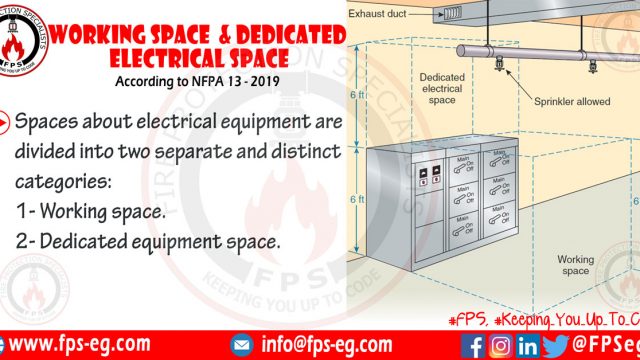
Spaces about Electrical Equipment
There are two categories of spaces about electrical equipment:
Working Space & Dedicated Electrical Space According to NFPA 70 (NEC)
1- Dedicated Electrical Space, this term applies to the space reserved for future access to electrical equipment and to protection of the equipment from intrusion by nonelectrical equipment.
2- Working Space, this term applies to the protection of the worker. So, Access and working space shall be provided and maintained about electrical equipment to permit ready and safe operation and maintenance of such equipment.
The space equal to the width and depth of the equipment and extending from the floor to a height of 1.8 m above the equipment or to the structural ceiling, whichever is lower.
Note that: Dedicated Electrical Space shall be dedicated to the electrical installation, no piping, ducts, leak protection apparatus, or other equipment foreign to the electrical installation shall be located in this zone.
To know more about installation of sprinklers and sprinkler piping in electrical rooms, please visit the link below:Installation of Sprinklers in Electrical Rooms
These equipment's require examination, adjustment, servicing, or maintenance while energized. So, working space shall comply with the dimensions of the followings:
The depth of the working space in the direction of live parts shall not be less than that specified in the following table:
Working Space & Dedicated Electrical Space According to NFPA 70 (NEC)
Note that: Distances shall be measured from the exposed live parts or from the enclosure or opening if the live parts are enclosed.
Note that: The depth of the working space in the direction of live parts could be less than the values mentioned in the above table if any of the followings cases exist:
(a) Dead-Front Assemblies: Working space shall not be required in the back or sides of assemblies, such as dead-front switchboards, switchgear, or motor control centers, where all connections and all renewable or adjustable parts, such as fuses or switches, are accessible from locations other than the back or sides.
Where rear access is required to work on nonelectrical parts on the back of enclosed equipment, a minimum horizontal working space of (762 mm) shall be provided.
(b) Low Voltage: By special permission, smaller working spaces shall be permitted where all exposed live parts operate at not greater than 30 volts rms, 42 volts peak, or 60 volts dc.
(c) Existing Buildings: In existing buildings where electrical equipment is being replaced, Condition 2 working clearance shall be permitted between dead-front switchboards, switch gear, panel boards, or motor control centers located across the aisle from each other where conditions of maintenance and supervision ensure that written procedures have been adopted to prohibit equipment on both sides of the aisle from being open at the same time and qualified persons who are authorized will service the installation.
The width of the working space in front of the electrical equipment shall be the width of the equipment or 762 mm, whichever is greater. In all cases, the work space shall permit at least a 90 degree opening of equipment doors or hinged panels.
The work space shall be clear and extend from the grade, floor, or platform to a height of 2.0 m or the height of the equipment, whichever is greater.
Within the height requirements of this section, other equipment that is associated with the electrical installation and is located above or below the electrical equipment shall be permitted to extend not more than 150 mm beyond the front of the electrical equipment.
Exception No. 1: In existing dwelling units, service equipment or panel boards that do not exceed 200 amperes shall be permitted in spaces where the height of the working space is less than 2 m.
Exception No. 2: Meters that are installed in meter sockets shall be permitted to extend beyond the other equipment. The meter socket shall be required to follow the rules of this section.
Exception No. 3: Where top terminal batteries are installed on tiered racks or on shelves of battery cabinets, working space in accordance with the battery manufacturer’s instructions shall be provided between the highest point on a cell and the row, shelf, or ceiling above that point.
আমি আনিসুর রহমান জুয়েল। Senior Engineer, Signal Technology & Engineering Ltd., Dhaka-1207। বিশ্বের সর্ববৃহৎ বিজ্ঞান ও প্রযুক্তির সৌশল নেটওয়ার্ক - টেকটিউনস এ আমি 6 বছর 4 মাস যাবৎ যুক্ত আছি। টেকটিউনস আমি এ পর্যন্ত 8 টি টিউন ও 0 টি টিউমেন্ট করেছি। টেকটিউনসে আমার 1 ফলোয়ার আছে এবং আমি টেকটিউনসে 0 টিউনারকে ফলো করি।